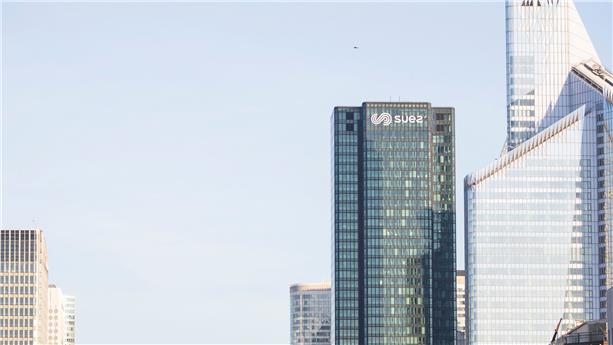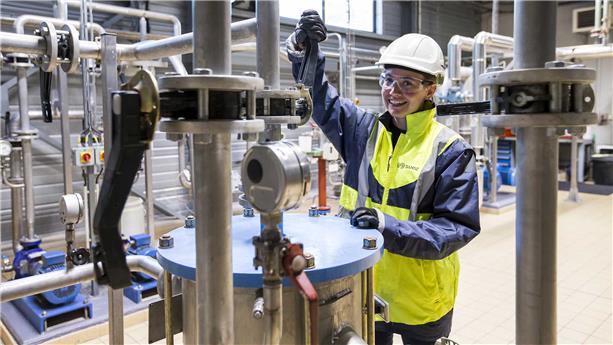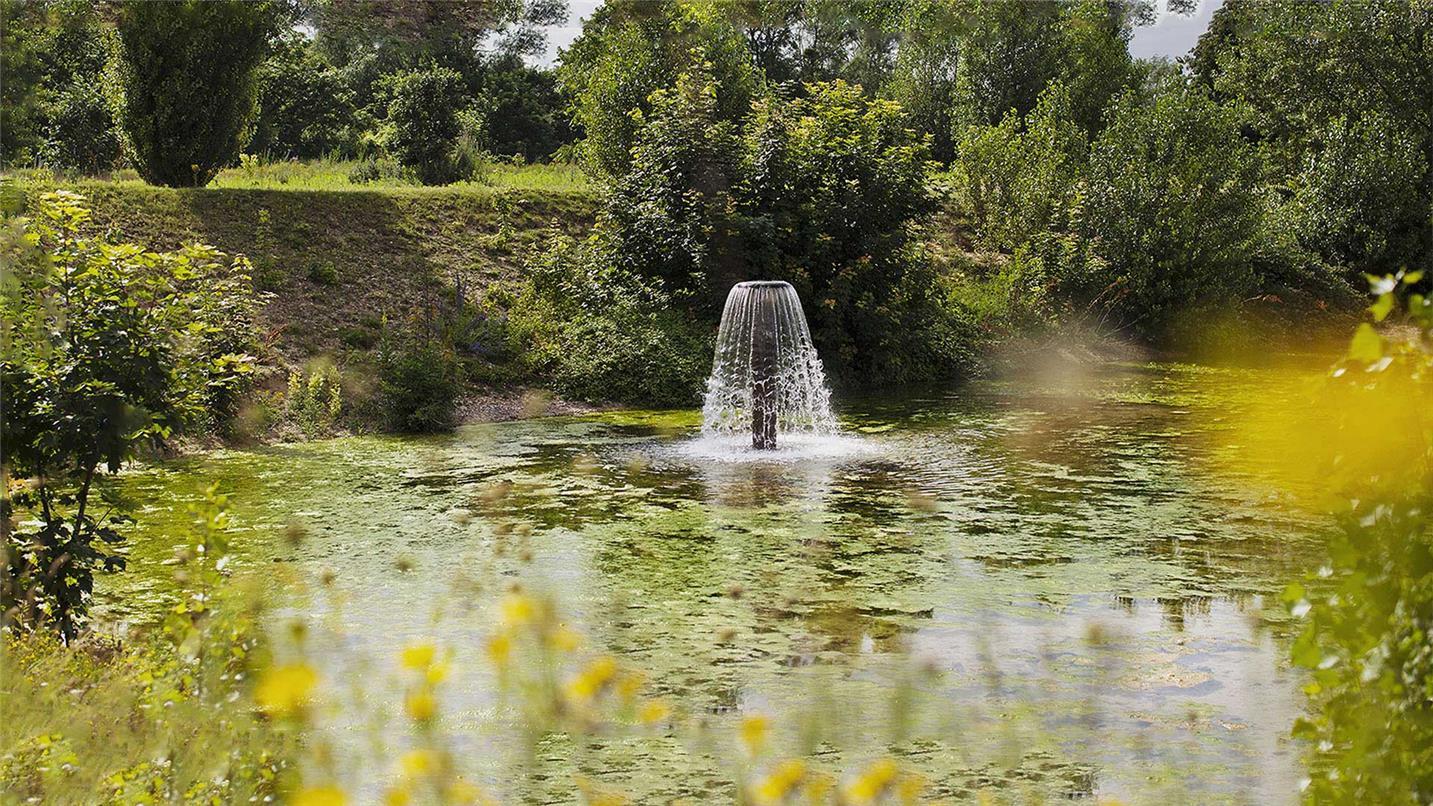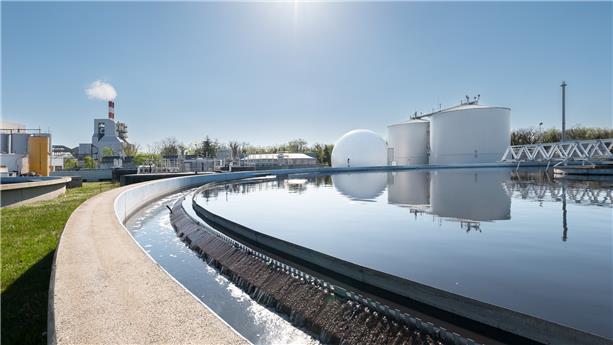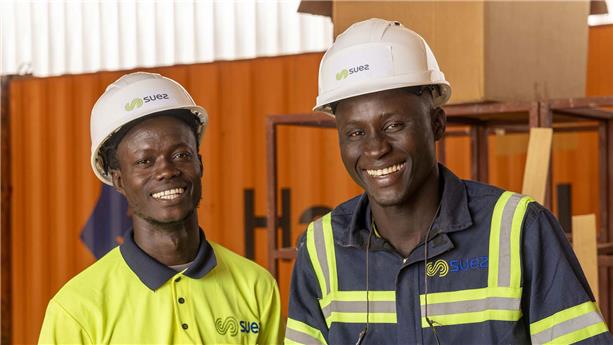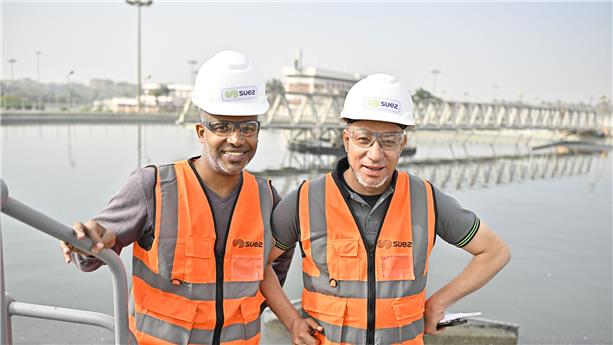
At SUEZ, we have put water at the heart of our innovation strategy.
- We are developing innovative circular solutions to ensure responsible management of water resources.
- We are focusing on optimising consumption and combating leaks in order to reduce the pressure on resources.
- We are deploying treatment solutions that allow us to analyse, detect and remove micropollutants, including pfas, in order to ensure high-quality water.
- We offer alternative solutions such as the reuse of treated wastewater and seawater desalination in order to address the consequences of drought.
Globally, almost 30% of drinking water is lost in networks between the plants in which it is produced and its final destination. In France, the proportion is around 20%. In addition, post-meter leakage on users’ premises amounts to 8-10% of the drinking water produced. As well as the obvious economic cost, these water leaks have an environmental impact because resources are lost and leaks contribute to soil erosion, landslips and property damage.
To help operators detect leaks more effectively, and preserve water sources, SUEZ has developed solutions that use leading- edge technologies such as the internet of things (IoT), artificial intelligence (AI) and data analysis.
Our innovation in action
SUEZ offers proven technologies that combine data science, water-related expertise and local knowledge to detect problems and leaks in drinking water distribution networks, and thereby achieve better control over consumption and the environmental impact.
Using AI to combat leaks in water networks
The IAcoustique solution enables users to understand acoustic signals emitted by the network in order to detect possible leaks. It uses an AI algorithm that analyses thousands of pieces of data collected by sensors installed in water networks (flow meters, pressure sensors and consumption meters), along with data from the library of leak sounds recorded and confirmed by SUEZ’s experts across the 100,000 km of networks it operates in France. IAcoustique is integrated into the Aquadvanced® Water Networks digital platform, which offers a comprehensive view of how water networks are operating, thereby reducing the time taken to detect leaks and improving network efficiency ratios, reducing water losses by 20%.
5 X
With a population that increases sharply in the summer season and given the impact of climate change, the Cannes region faces major challenges in terms of conserving its water resources. SICASIL (Syndicat Mixte des Communes Alimentées par les Canaux de la Siagne et du Loup) has granted SUEZ a nine-year contract to produce and distribute very high-quality drinking water to eight towns in the Cannes region, home to over 180,000 people.
This service is provided by SUEZ group subsidiary SO’EAU and has already resulted in the installation of 700 sensors. By the end of September 2025, the plan is to install 21,206 smart meters to monitor most of the water consumption taking place in the region and detect leaks in the network and on consumers’ premises more quickly. Ongoing network analysis covering 1,035 km of the network takes place in order to limit the duration of any leaks, reduce the volume of water lost and allow rapid response by SO’EAU’s teams.
Preventing leaks in the home using remote water meter-reading
SUEZ has designed and developed ON’connect™, a remote solution that monitors water consumption constantly by automatically reading water meters, and generates alerts in the event of leaks or unusually high consumption. The SUEZ group is now Europe’s leading player in remote meter-reading, with almost 7 million meters installed around the world1. Remote meter-reading means that users can monitor their consumption closely, respond quickly to any leaks and adopt more efficient practices, for example by reducing consumption and installing more efficient equipment. On average, SUEZ’s consumer and business users equipped with remote meter-reading solutions reduce their water consumption by 16%.
7 million
WSC, the company in charge of water and wastewater services in the Maltese islands, started to invest in rolling out smart water meters in 2009. Today, more than 310,000 smart meters have been deployed, resulting in coverage of more than 96% of the territory. With the data collected and processed by SUEZ’s ON’connect™ solution, all customers in the Maltese islands can monitor their water consumption and almost 3,500 notifications are sent every month to alert them in the event of unusually high consumption. The service allows consumers to reduce their bills and save water, and enables WSC to improve the efficiency of its network, respond to problems and reduce leaks.
Improving the performance water networks by monitoring smart meters
Following on from the success of the Smart Operations Centre in Pecq in the Paris region – a monitoring centre that for 10 years has co-ordinated the monitoring of 3 million smart meters across France to improve the performance of water networks – SUEZ is continuing to develop its activities in this area. In March 2025, the Group opened its Smart Operations Centre in Maidenhead in the UK, which will collect and analyse data from millions of smart water meters across the country. The aim is to allow operators to monitor water networks continuously and identify potential failures or leaks as early as possible.
—
“Traditional leak detection methods, such as acoustic detection, are effective but rely on human expertise and the analysis of basic data. By incorporating AI and advanced data processing into these technologies, we are making leak detection more effective and allowing operators to detect leaks in water networks earlier and more accurately.”
Claire Mathieu, Head of data & IA SUEZ
—
Sewage networks are subject to wear and tear and corrosion, and must be upgraded regularly. In France, it is estimated that only 5% of the sewage network is inspected every year, while only 0.5% is upgraded. This means that infrastructure built to have a useful life of 60-100 years is actually being used for 200 years.
It is now necessary to invest heavily in upgrading sewage pipes to ensure effective wastewater services and adapt them to climate change, particularly instances of drought and flooding. This represents a considerable amount of work, and local authorities must prioritise which parts of the network to upgrade first.
Our innovation in action
SUEZ, which operates around 75,000 km of networks in France, has developed its Sewer Family, a range of innovative solutions for monitoring the condition of wastewater networks in order to guide local authorities in their sewage pipe maintenance work and help them take decisions.
With SewerBall, a patented smart ball measuring 70 mm in diameter – SUEZ offers its customers an autonomous network inspection tool. There is no need for people to go down into the sewer: SewerBall has built-in sensors that analyse all physico- chemical parameters (pH, temperature, conductivity and redox potential) of the network, along with a geolocation system. The data collected is then interpreted by a proprietary SUEZ algorithm to identify problems in the network, without having to clean out or empty the sewer, which would result in service interruptions and entail significant costs.
+ 1300
SUEZ has also developed SewerBall Camera, a smart ball 115 mm in diameter that is carried along by the flow of sewage water and can provide a 360° view of pipes in order to carry out a precise analysis of the network’s condition and help the local authority prioritise work. The camera is larger than the SewerBall, can travel long distances (up to 5 km of pipes analysed per day) and can reach networks that are difficult for people to access, with no service interruptions.
With the Sewer Quad, a four-wheel-drive remote-controlled drone, SUEZ’s teams can take 360° images of networks to create a digital twin of the infrastructure being inspected, and locate connections, damage and buried manholes. It gives access to networks that are too small for people to enter (less than 500mm in diameter), including those with a contaminated atmosphere. Finally, the Sewer Drone is a remote-controlled flying drone with a high-definition camera, allowing teams to carry out analysis work quickly (covering over 100 metres in a few minutes) and across large distances.
The combination of the SewerQuad, SewerDrone and SewerBall solutions allows sewage network operators to maximise the number of situations they can deal with and to access all of their infrastructure. With this Sewer Family, SUEZ allows local authorities to analyse their infrastructure quickly, economically and safely, helping them to manage repair work as well as the required investment.
“The ease of use and the amount of data collected by the SewerBall are impressive. We were able to inspect almost 6km of water network – three times the 2km we initially planned to inspect – even though access was difficult, in the bed of a river with steep banks. The physico-chemical measures made possible by the SewerBall provided an essential complement to visual inspection. The data allowed us to locate and quantify water intrusions so that we could prioritise repairs.”
Bruce Rozan, Water department of the City of Lausanne (Switzerland)
—
Climate change is disrupting the water cycle: sometimes there is too much water, sometimes not enough. Communities need to adapt to this new situation in order to manage their water resources more effectively and deal with prolonged droughts, erratic precipitation and devastating floods.
Groundwater represents a genuine natural reservoir and is our primary ally in managing water resources, which are becoming less reliable. SUEZ has developed global expertise in groundwater recharge, combating falling groundwater levels by forcing water to infiltrate into the soil.
Our innovation in action
In the Métropole Toulon Provence Méditerranée region, the town of Hyères-les-Palmiers has a remarkable diversity and natural wealth: it consists of three islands, a peninsula, 40 kilometres of coast and 23 kilometres of beaches, large areas of farmland and forests and a historic town centre. These natural riches are a big draw for tourists, which increase Hyères-les-Palmiers’ population by a factor of four during the summer season. This means that the town must adapt to the influx of tourists while maintaining a pleasant living environment as well as a high level of service for local people.
When the local authority asked for assistance, SUEZ set up the Aqua Renova project to improve the way withdrawals from the island’s groundwater are managed, and to restore the Bas- Gapeau water table by recharging it through the infiltration of freshwater, known as managed aquifer recharge (MAR). The technique is inspired by nature and allows the water table to be recharged with surface water in winter – when it is plentiful – in order to create a buffer between the aquifer and the sea. Combined with improved management of the Bas-Gapeau water table using the gradient method, the water table is protected from saltwater intrusion and the city can remain self-sufficient even during a drought.
88%
In recent years, Europe has seen some severe episodes of flooding. In July 2021, Germany and Belgium were hit with historic rises in water levels. In the winter of 2023-2024, the Nord-Pas-de-Calais region of France saw major flooding and a thousand people had to be rehoused. In October 2024, the region of Valencia in Spain experienced deadly flooding.
These violent phenomena are becoming increasingly common because of climate change. This is prompting local authorities to take early action and adapt to the growing threat, and stormwater basins built around certain large cities can contain excessive rainwater. According to the European Court of Auditors, the cost of flood damage across the EU is likely to rise from €7 billion per year between 1981-2010 to €46 billion per year in the 2050s, and to €98 billion per year in the 2080s1.
Our innovation in action
SUEZ has developed AI-based digital tools to help local authorities anticipate the risk of high water levels and coastal flooding, and to adapt their infrastructure to deal with these unpredictable meteorological phenomena as effectively as possible.
Anticipating and limiting the risk of high water levels for urban infrastructure
SUEZ is working with Singapore’s National Water Agency – otherwise known as the Public Utilities Board or PUB – to extend and maintain the system for monitoring reservoirs and rainwater collection zones in the city-state. The project is part of PUB’s roadmap for meeting Singapore’s water needs and using resources in the most efficient way using digital technology. The Aquadvanced® platform has been in place since 2016 at the Marina Barrage, and has been extended to the whole of Singapore to check the condition of reservoirs and canals using data from the rainwater network and weather forecasts. The aim is to limit the risk of flooding and improve the way the city-state manages its water resources.
Understanding coastal flooding risks in order to protect local populations
SUEZ is also working with entities in charge of managing coastal areas to forecast coastal flooding risks, with the aim of protecting local people and infrastructure. The city of Biarritz in Southwest France is highly exposed to large swells in the Atlantic Ocean. The local authority asked SUEZ to monitor the impact of storm surges on the seafront and anticipate the associated risks. The Group put in place the Aquadvanced® solution, which is based on data collected in real time and predictive modelling using meteorological and oceanographic parameters (waves, tides, wind, atmospheric depressions) to watch over each area affected by coastal flooding risks, such as beaches and infrastructure locations.
The system allows users to monitor and predict changes in water levels along the coast, possible instances of the sea overflowing onto the land, and potential damage when waves break through protective structures. Using the system, operators can anticipate a storm three to five days before it occurs, and then track developments hour by hour as the storm progresses. The solution is the culmination of ten years of research by SUEZ in the Basque Country, in collaboration with the Group’s clients and scientific partners. Innovation is continuing through the research done by KOSTARISK, a laboratory operated jointly by the Université de Pau et Pays de l’Adour, Fondation AZTI and SUEZ’s Rivages Pro Tech centre.
—
“At SUEZ, we are innovating in order to help local authorities anticipate, manage and reduce the impact of high water levels and floods. Using our smart solutions combined with leading-edge technologies such as data analysis and artificial intelligence, we offer effective tools for protecting the environment, property and people, while also limiting operational costs.”
Antonin Fradin, Head of Smart Water Solutions, SUEZ
—
Per- and polyfluoroalkyl substances (PFAS) produced by the chemicals industry, otherwise known as “forever chemicals”, have become a major public health and environmental pollution issue.
In France, defining and checking compliance with public health standards are the responsibility of the health authorities.
Currently, European regulations – transposed into French law into 2023 – require them to look for 20 types of PFAS in drinking.
Our innovation in action
SUEZ is making water quality a key priority in its research activities. In 2018, CIRSEE – its centre of research and excellence – began an R&D programme to detect, analyse and assess the presence of PFAS in water, and then to devise innovative processes and methods to treat all water and thereby preserve water resources. SUEZ can now detect 65 types of PFAS in water (water courses groundwater and drinking water) including TFA, the smallest molecule in the PFAS group. Its method of analysing PFAS can also be applied to wastewater, sewage sludge and leachates from waste storage centres.
In addition, SUEZ can design, build and operate various systems for treating PFAS that may be present in water sources and drinking water. There are several proven technologies – such as activated carbon adsorption, nanofiltration and low-pressure reverse osmosis – that can be used to treat PFAS and produce drinking water that complies with regulations. SUEZ has a long-standing expertise in these solutions. Deciding which one to use depends on the quality of the water to be treated and the client’s wishes.
Activated carbon adsorption
Adsorption allows micropollutants to adhere to a solid surface consisting of activated carbon in granular form
within a filter.
Nanofiltration
Low-pressure reverse osmosis
Ternay, located in “Chemical Valley” to the south of Lyon, is on the front line in terms of PFAS pollution in water. After these chemicals were detected in water in 2022, the Southern Rhône region’s drinking water management authority decided to act.
The authority used SUEZ’s expertise to implement a long-term PFAS treatment solution so that it could provide high-quality water to its 170,000 users.
170,000
Firstly, PFAS analysis was carried out to gauge the nature of the pollution. SUEZ then carried out a series of laboratory tests in its international research centre CIRSEE to identify which PFAS treatment technology would be most effective.
The solution it selected consists of activated carbon filters that are continuously renewed: this is a patented SUEZ technology, and results in a modular solution that can be integrated into existing treatment plants. An industrial pilot – involving tests carried out in the actual conditions encountered in a treatment plant – was performed to corroborate the laboratory results.
SUEZ has operated the Ternay drinking water treatment plant since 2016, and in March 2025 began modernisation work to incorporate the PFAS treatment system. The six activated carbon absorption filters already in use will be fitted with Carbazur® Simplex technology, allowing the activated carbon to be continuously renewed. Activated carbon is automatically injected and extracted for regeneration in a way that does not interrupt the operation of the plant. In addition, the frequency with which the carbon is renewed can be adjusted to changes in the quality of the raw water entering the plant, i.e. increases or decreases in the concentration of PFAS.
“SUEZ can treat PFAS in water in order to produce drinking water that meets the new regulatory limits. We are very proud to be working alongside the Southern Rhône region’s drinking water management authority as part of this project, the first of its kind in France, which will protect the health of our fellow citizens. These solutions can also be adapted to treat PFAS in municipal and industrial wastewater.”
Gilles Boulanger, Director of CIRSEE
—
The reuse of treated wastewater (RTW) is a practice that is used to varying extents around the world. In France, 0.6% of water in the network is reused, as opposed to 91% in Israel, 14% in Italy and 8% in Spain5. However, wastewater can be a precious resource for communities suffering water stress, particularly when they are far away from the coast.
Once treated, wastewater can be reused for purposes as varied as crop irrigation, watering of green spaces and industrial processes such as cooling, washing and manufacturing. It can also be reinjected into groundwater to help replenish underground water reserves and, in some regions, it can be used for non-drinking applications at home, such as washing the car or paths, or watering green spaces.
Using wastewater several times makes it possible to limit the amount of water removed from a community’s resources and to conserve drinking water for other uses such as drinking, cooking and personal hygiene. RTW can even be used to produce drinking water depending on the local context.
Our innovation in action
An RTW project involves various aspects: sociological (social acceptability of reusing treated wastewater), administrative environmental and technological SUEZ has developed comprehensive expertise in helping local authorities determine whether an RTW project is right for them and in implementing projects as the case may be. All projects require a prior study regarding the environmental impact, particularly in situations where wastewater helps maintains the minimum flow of a water course in summer.
Having carried out more than 50 RTW projects and with its range of solutions covering the various uses of treated wastewater, the Group can produce reused water suitable for all purposes: the complexity of the treatment method differs according to how the treated water will be used.
The technologies most commonly used are:
- Filtration: using sand, discs or membranes (ultrafiltration)
- Disinfection: chlorination, ultra-violet radiation, ozonation etc.
+ 50
For some purposes, particularly the production of drinking water, additional technologies are used to:
- Remove micropolluants from the reused water through activated carbon adsorption, ozonation and reverse osmosis filtration
- Reduce salinity and remove other minerals, using nanofiltration, reverse osmosis and electrodialysis
Various wastewater treatment processes depending on the intended use
The most frequently used treatment processes are filtration (using sand, discs or membranes – ultrafiltration – and disinfection (chlorination, ultra-violet radiation, ozonation). For some purposes, particularly the production of drinking water, additional technologies are used to remove micropollutants (activated carbon adsorption or reverse osmosis filtration) and reduce salinity and certain minerals (nanofiltration, electrodialysis).
Various levels of Membrane filtrationcan be applied to the wastewater depending on the intended use:
- Aquazur® sand filtration
- Ultrablue® ultrafiltration
- Ultrafor® ultrafiltration with membrane bioreactors
- Reverse osmosis
The new wastewater treatment plant will be able to produce around 3.6 million m3 of water per year, the equivalent of around 1,500 Olympic-sized swimming pools. In addition, it will be possible to recycle 85% of the crystallised salt products extracted from the high-salinity wastewater to produce sodium sulphate via the treatment process.
Between two and three billion people across the world are experiencing water shortages and the situation is likely to get worse in the coming years. Water demand is constantly rising, particularly as a result of growth in the world’s population, freshwater resources are being seriously affected by climate change and the world’s water courses are experiencing levels of drought not seen since 1921 Glaciers are melting at an ever-faster rate, endangering freshwater supplies in many regions of the world. By 2030, global demand for freshwater is expected to exceed supply by around 40%1.
At SUEZ, we are working with communities to manage water in a structured way, in order to reduce pressure on available resources and, where necessary, make use of alternative resources. The latter could arise from the reuse of treated wastewater and the desalination of seawater and brackish water in coastal areas experiencing water stres
Our innovation in action
Desalination is now a mature solution, with applications that can vary according to the local context.
- The process can use seawater, but also brackish water, which is a mixture of freshwater and seawater found in places such as river estuaries and lagoons.
- It can ensure a constant supply of water, as is the case in many Middle Eastern countries, or provide a back- up solution to be used in the event of a drought.
- It can be used to produce drinking water or industrial process water.
SUEZ is a world leader in desalination solutions. We have built more than 260 desalination plants around the world, providing our clients with robust, tried-and-tested solutions.
Our long-standing expertise, combined with our investment and innovation capabilities, mean that we can develop ever more advanced technologies to improve desalination performance and offer solutions that are increasingly sustainable and accessible.
+ 260
Our SeaDAF® range, for example, maintains the integrity of reverse osmosis membranes – used to filter seawater – in cases of poor water quality, for example when there is a large amount of seaweed. SeaDAF® Filter is a commercially available piece of equipment that combines two stages of treatment in a single unit, reducing the environmental footprint by 25%
We have also been working on the brine discharged by desalination plants for many years now. We have developed digital modelling systems and diffusers that dilute the brine more effectively in seawater. We can also connect desalination plants with wastewater treatment plants to dilute the brine with treated wastewater before discharging it into the natural environment.
We are developing circular solutions to recover materials from brine and thereby help to create new resources. In particular, we can:
- Extract and recover CO2 in order to use it to reduce the alkalinity of the water produced;
- Produce higher-quality freshwater by remineralising it using a mixture including calcium and magnesium extracted from brine;
- Produce acid that can be reused to pretreat seawater and to clean reverse osmosis membranes
Finally, to reduce the carbon footprint of the desalination process, we can now supply renewable energy to production plants.
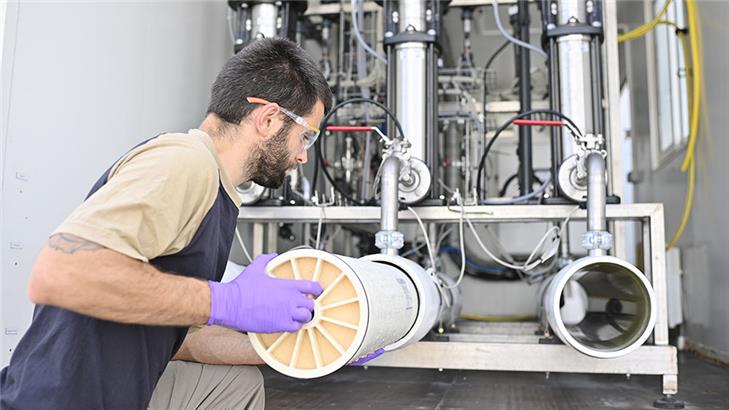
“Each of the desalination plants we design and build is a response to the local issues of each community. But one thing they all share is their use of high-precision technologies to achieve the best possible economic and environmental performance.”
Yvan Tréal, Commercial Director Engineering & Construction at SUEZ
—
